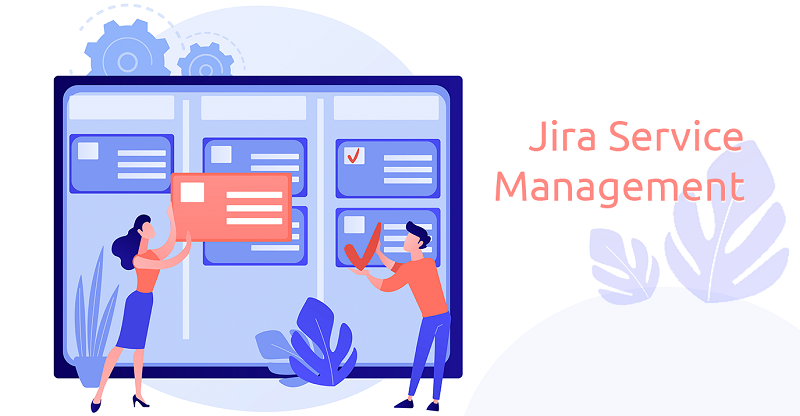
Jira Service Mangement: What is it and how has it evolved
Ruth Moreno
Almost a year after our announcement of “Jira Service Desk evolves to Jira Service Management” and the entry of Cloud products into the Atlassian family we want to look back at the evolution and how their products have matured ever since.
The first thing that came to my mind was why the Server version was disappearing and the actual number of users that would be affected by this change. I didn’t think the Cloud platform was mature enough to be offered to our customers. And nothing could be further from the truth, a year later I believe that Atlassian Cloud offers a robust working platform and while that is true, it has to adapt to your working methodologies and it is not so easy to maintain your old business habits.
For anyone joining the family now, we need to explain that Atlassian Cloud has evolved its core products into unique products in their own right, and at the same time has given them the flexibility to work together, which is very difficult to do if we assume that not all teams have, or work in the same way.
It must be said that Atlassian’s tools are very powerful for working with agile methodologies so that, in some cases, an organisational change is also required if you want to extract its full potential. Although in this evolution that we are dealing with it has been incorporated to its tools roadmaps or processes that facilitate mixed work or even a more traditional framework, thus covering any type of need.
Returning to the subject that concerns us today, I will start explaining what products you can currently get from Atlassian and I will focus on its Cloud part and not so much on Data Center Atlassian, which is currently evolving at a different pace. The first thing I must say is that Atlassian products, like other providers, have different licensing plans. In Atlassian we can find Free, Standard, Premium and Enterprise. In these, as with the rest of the providers, the higher the functionality, the higher the price.
Jira Work Management (previously Jira core Cloud or Jira Business)
Jira Work Management is arguably the product that has evolved the most to date. It was born as the core product and now has its own entity and is designed for all teams that do not need to use Scrum methodologies. Perhaps the most important feature is that if you buy Jira Service Management or Jira Software, you can also benefit from Jira Work Management. However, this one faces one disadvantage: you will only get it for the number of licences you have purchased. In other words, if you have 100 Jira Software teams, they will also be able to use Jira Work Management, but you will have to purchase specific licences for the latter to add to your business teams. The advantage is that if you only have 50 commercial teams, in the end 150 users are benefiting from this product.
What is Jira Work Management?
Atlassian promotes it for non-IT teams, but my experience with the product has taught me that any team can use it and it will only depend on the needs of your department or project being carried out.
Going into more detail, let’s highlight the most important points that Jira Work Management has and that will help us decide if it fits or can fit the way we want to work or manage the project.
In April 2021 the Atlassian Introducing Jira Work Management blog presentation was launched, explaining what it is and what its main attractions are. In the following lines I am going to show them and reveal its functionalities.
Capabilities
There is no doubt that it is a tool designed for the management of daily work, whether as a project or at the level of internal tasks. For those who do not know how Jira works, it works by projects. In this way, the same department can have more than one project depending on its needs and can link them together to share certain tasks. To create projects we will find a great variety of predefined templates for each occasion or we can create our own project creating the necessary and personalised flows. As an example I show you a few templates:
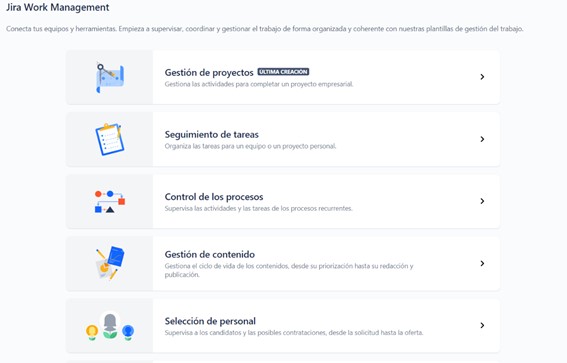
When we choose a template, what we are creating is a series of task types, workflows that we can start working with without having to create them individually. One of the things I like the most is to be able to start with a standard template and as we work we discover our own evolution and see that we need new features, more states in the flow or perhaps a new type of task and see that I can modify my project to adapt it to new needs, which other similar products do not allow me to do or it is quite a tedious task to do so.
To understand it better let’s see a practical case and let’s discover the capabilities and functionalities as we go along. The first thing to do is to choose a Project. To do it if we look at the previous image we will see that it already gives us a possible idea about the main needs we may have and a small description, but if it is not enough we can click on the one we consider and see it in more detail before deciding. In our example and because it is the newest we will choose Project Management.
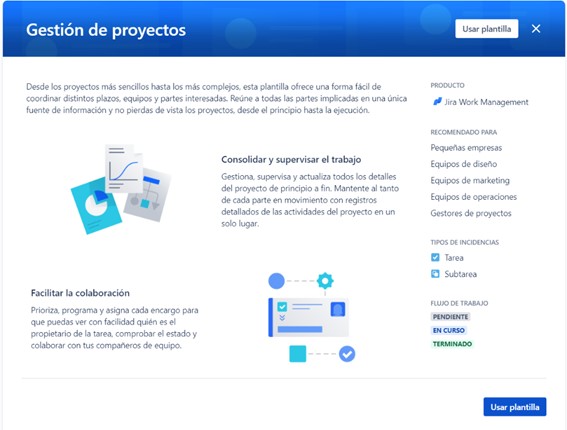
As we can see, it gives us a good explanation of what we are going to find and what we are going to use it for on the left-hand side. On the right hand side, it recommends who it is suitable for, the types of tasks that we will find in this project and what the workflow will be. For those who do not understand very well what the workflow is, it is nothing more than the actions that we carry out from the moment we start a task until we finish it. In our example it will be: When we create a new task it will start in a pending status because we haven’t started working on it yet, when we start working on it we will move it to in progress and when we finish it we will move it to finished. Simple, isn’t it?
Every project needs an identifying name and a key. The key is important because all our tasks will be composed of this key plus a number. Atlassian will also ask us which team it is for, because classifying it will help us to filter it later by this kind of fields that will help us to see only what is relevant for us.
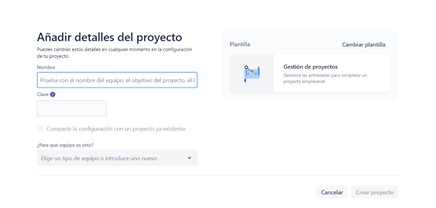
People who already work with Jira will realise that up to this point there is no difference between Jira Service Management and Jira Software, so up to this point we can see that by knowing how to use one we can adapt very quickly to the rest of the products in the same Suite. It is once the project has been created when we start to see the differences between the different products. Jira Software and Jira Work Management enjoy a board view, in this case Kanban, leaving the scrum board only for Jira Software products. The overview of our project will be as follows:
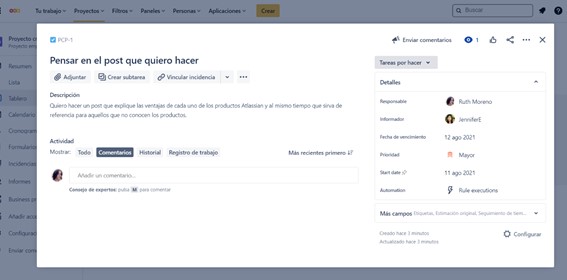
Our Kanban board will show me my tasks with my workflow as if they were post-its and I will be able to move them from one position to another by simply dragging the card (post-it) to the new state.
The best thing about this board is that I will not only see my tasks but also those of my colleagues, so we will all know what we are working on at all times and what tasks remain to be done. We have many other features on our cards such as being able to prioritise them, set a due date, assign them, add a description with images, videos… Attach files, I can even add automations to help me get my tasks done faster. Of course we must not forget that we work in collaborative environments so forget the mail and add comments to the tasks so that everything is in its place and easier to locate.
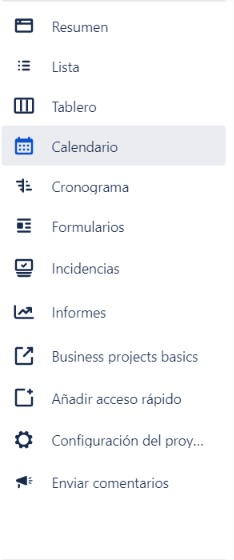
Now we know the basics and most important but Jira Work Management has many more features that we are going to discuss not only can you see the progress from the dashboard, but we can also see it as we see fit at any time. If using the dashboard was very convenient to move from one state to another, the calendar gives us a view of when a task starts and when it ends if we have specified it in our task.
Another great feature is that it does not forget the supervisors who need a broader view to see the evolution of the project and this could not be done without our Gannt view that Atlassian calls Chronogram. While it is true, depending on the licensing version chosen you will have more or less options in this timeline. Another feature that has fascinated me is the ability to create forms to collect information from other departments or stakeholders, like a mini customer service.
In addition, we have a list view, incident view that will allow me to filter and create custom filters to visually obtain reports in list mode, project summary and of course reports already created to help me in the daily management. Another feature that if it is less relevant has been added recently is to be able to give background colour to our project, which is something that brings it closer to our already known Trello and that we could consider it as the smallest of this family.
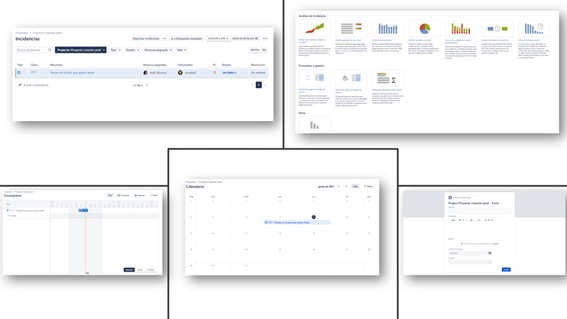
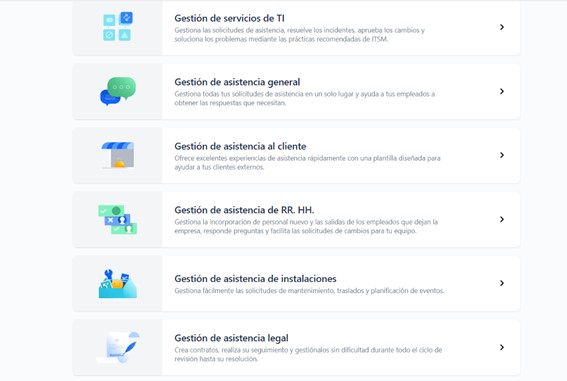
As we have seen, Jira Work Management allows me to manage my entire company either by internal tasks or by projects in an easy way and designed for all levels. It is quick to learn, you can start without knowledge and expand it with the help of partners such as atSistemas to adapt to new needs and provide more and more value to the company. The only drawback I have found is that for the moment they have not thought of integrating it with Confluence, as they have done with the rest of the products, which we will see in the following sections. But that doesn’t mean that we can’t use it and link its pages or the project itself with our Confluence space. We will have to do it from our document manager, Confluence. Hopefully, in the future, we will be able to have our documentation directly in our Jira Work Management.
Jira Service Management (formerly Jira Service Desk)
If Jira Work Management allows me to manage all the business areas of my company, Jira Service Management allows me to manage my customers, my suppliers, my students, my employees’ problems and my assets. And all sectors need it to offer quality of service. Schools or universities to offer parents, students and suppliers personalised assistance with self-help answers. Our customers to be able to explain to us what is wrong with our products or simply to bring in new sales. Our employees always have needs and we manage everything by mail, losing them or without being able to analyse how much time we waste in solving these problems. And what about if you could attend to future new employees in this way. From their application, through the interview and ending with their entry or resignation, what if you could order material, a new software or be able to say that your keyboard has broken and the one that corresponds to the employee would appear directly?
All this functionality and more is what you will find in this tool. And best of all, does your company need to comply with ITIL? Jira Service Management has a certified service desk to comply with your ITSM.
As in the rest of the products, getting started is very easy thanks to its templates such as IT Service Management, recommended for ITSM. General support management, which helps us to manage any questions or suggestions our employees, students, etc. may have ….. Customer support management, the same as the previous one but oriented to our customers. HR support, from the interview to changes in the team, you decide how far you want to go. One of my favourites Facilities support management, which helps us to easily manage maintenance requests, transfers, event planning… or, for example, legal support management, create contacts, follow up on them, until resolution. And if none of them fit you, create your own.
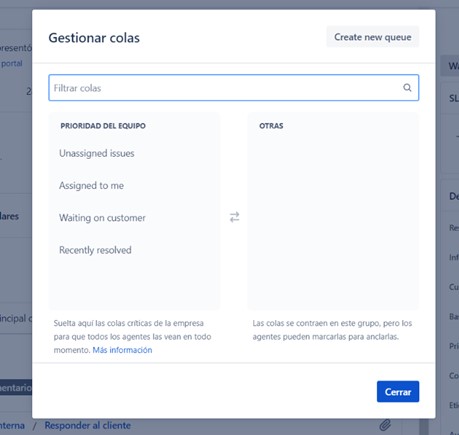
As with the rest of the products, before deciding you can enter each section and find out what the template offers you and thus choose the one that suits you best. For those who do not know Jira Service Management, it is important to explain that unlike the other products, this one has a user portal with its forms and self-help if you decide to have it thanks to the Confluence complement that allows you to have an intelligent knowledge base to offer the user the best response.
In this way, Jira Service Management will have two platforms within its project:
- The one we show to our customers (user portal).
- Our internal project where we will receive the requests that have been made from the previous portal.
Although the two are linked and one cannot function without the other, it is important to know that our Portal users do not consume a licence, so offering this service is free of charge. What we should know is that there are functionalities that only exist for certain types of licensing and that if we want to ensure that we can have a catalogue of the company’s assets, for example, we must have the Premium version. In order to see the differences between the different licences, we must go to this page Prices: Jira Service Management | Atlassian where we can also see the evolution of these.
Since Jira Service Desk changed to Jira Service Management, a number of changes have been made, especially at Cloud level. The most important have been the acquisitions that have allowed it to grow in Enterprise Service Management (ESM) and IT Service Management (ITSM) solutions. The most important integrations are:
- Mindville Insight (CMDB) for asset and configuration management.
- Opsgenie for alert and on-call management
- Halp for conversational ticketing
- ThinkTilt the tool allows service management to scale and adapt more quickly thanks to its cascading and dynamic forms management.
But these improvements do not stop there, although there was already a link in the knowledge base with Confluence, its integration is now much more solid and necessary than ever in order to offer the user a much broader and more comfortable experience. Another improvement is the customisation of the portal, which is much more convenient and extensive, and the ability to democratise the administration of services by delegating administration permissions.
Another new feature is that we can manage work queues. If in Jira Work Management or Jira Software we had dashboards that helped us to work on a daily basis, in Jira Service Management it is represented by work queues. Now we can add the critical queues for the company so that all the agents can see them permanently and leave the rest of the queues in the background, but each agent can mark them to anchor them.
The potential of Jira Service Management does not end with the incorporation of all these functionalities, which means that any work team that needs it, whether technical or not, can benefit from it to offer a better service, but like any self-respecting user service, it has the creation of SLAs (resolution times, creation, etc.), automatisms that help us to offer automatic responses to our clients, escalate requests to another status or replicate the request to another project for teams that are working at another level and that the requests are linked to be able to follow up on both. In this way, we can easily connect our incident manager to our own projects, either Jira Software or Jira Service Management, or both if required. Among all these improvements, we cannot forget the integration that has been made for DevOps teams, which allows the integration of Bitbucket and Jenkins.
In summary, we can say that Jira Service Management allows us to easily receive, track, manage and resolve customer or team requests. Customers can send requests via email, with a customisable help centre and a widget embedded in any website. In addition, Jira Service Management makes it easy to categorise service requests, incidents, problems and changes by organising and prioritising these requests in one place, and keeps teams on their toes in order to meet targets (or service level agreements).
Although depending on the licensing we will have more or less options we can say that the main features of Jira Service Management and that all versions have them are:
- Work queues: where agents work on customer requests.
- Dashboards and reports: reports to visualise trends in projects
- Channels: different ways in which customers can submit requests. In channels, you can configure and edit email channels, customer portal and widgets.
- Customers (user portal): Customers are unlicensed users who submit requests to your service team via the portal, email or widget. Jira Service Management converts customer requests into tasks that agents can work on.
- Project Settings: The project settings are where you configure the service project. Here, you can configure request types, link your service project to an email account, manage administrators, agents and end-user permissions, among others.
- Knowledge Base (if you contract Confluence): Knowledge Base articles appear in your portal so your customers can help themselves before opening a request.
- Customisable workflows: These are the states through which a request must pass. Probably a different type of workflow is needed depending on the type of request and it is in the creation of these workflows where we differentiate all these steps. From requests that need approval to requests that need to be escalated to other more technical teams.
- Basic automations: Automation helps to focus on the work that matters, eliminating the need for manual and repetitive tasks by allowing teams to automate their processes and workflows. With the simple rule generator, effective automation rules can be set up to control even the most complex scenarios. Depending on the licensing, more or less rules are allowed.
- SLAs: SLAs (Service Level Agreements) are a good tool for teams to keep track of how well they are meeting the service level expected by their customers.
Additional features available
If we use an IT Service Management (ITSM) project, we get some additional features by default. Some of them can also be enabled for other project types in Project Settings > Features.
- Service request management: Service requests are requests that are managed and resolved by a dedicated service team. For example, a request for a new laptop for a team member. This feature gives your team
- access to a dedicated request type of service requests
- dedicated service request queues
- service request reports
- Incident management: Incident management is a practice used by IT development and operations teams to respond to an unplanned event or service disruption and restore the service to operational status. This feature gives the team access to:
- a dedicated incident request type
- dedicated incident queues
- incident reports
- ways to escalate major incidents that cause the appropriate development and IT teams to swarm immediately and begin resolution
- The ability to link support requests directly to major incidents so that support agents can see status changes in real time
– Problem management: When a service has vulnerabilities, incidents can occur. Problems are the cause (or potential cause) of those incidents. This feature gives the team access to:
- a dedicated request type for problems
- dedicated problem queues and problem reports
- ways to group incidents into problems, which helps your team to quickly follow up on root cause analysis
- A place to record workarounds to minimise the impact of incidents
– Change management: Changes are the addition, modification or deletion of anything that may have an effect on services. Change management allows your company to flag, review and approve these changes before they can affect service quality. This feature gives the team access to:
- a dedicated change request type with an automated risk assessment workflow
- dedicated change queues
- change reports
- the ability to connect the CI/CD pipeline to your service project so you can track and lock down deployments with automated risk assessment
– Services: Services contain details of the products and applications used by the organisation, as well as the relationships between them. These can be used for a variety of features, including approving changes or knowing who to alert in the event of an incident.
– Alerts: Alerts allow the team to notify the appropriate people of incidents as they occur. This feature gives the team the ability to:
- centralise and filter alerts across all monitoring, logging and CI/CD tools to ensure that teams respond to issues quickly
- keep stakeholders aware of updates using multiple notification channels, including SMS, email and mobile push, and share status information with internal and external users through direct integration with Statuspage
- create chat channels (Slack, MS Teams), set up video conferences (via a native video bridge or Zoom) and automatically record all actions with an incident timeline
- Create automation rules to quickly investigate and correct incidents
– On-call scheduling: Allows the team to see who is on the list to be called on-call for their incident. This feature gives the team the ability to customise on-call schedules, routing rules and escalation policies to handle alerts differently based on their origin and urgency.
Jira Software
Jira Software is Atlassian’s flagship product. We could say that it is also the most mature and where most of the effort has been focused so far. Already on their product page they define it as the project management tool for agile teams and add the main features of the product:
- Kamban Dashboards
- Scrum dashboards
- Roadmaps
- Agile reporting
- Code and deployment status query
- Optimisation with automations
- Customised filters
- and all the functionalities we already know from project management for development teams.
In this product the great features are obtained when we license in Premium and its focus is focused on the teams to evolve to this type of licensing to obtain greater success in their day to day. The premium version offers us:
In this product the great features are obtained when we license in Premium and its focus is focused on the teams to evolve to this type of licensing to obtain greater success in their day to day. The premium version offers us:
- Advanced roadmaps that allow us to cover multiple teams and projects and takes into account team capacity and dependencies.
- Work automation at scale: Allows you to set up automation rules and add them to as many projects as you like, including many templates to facilitate automation of everyday tasks.
- Releases Tracks: Controls and enhances the end-user experience with change management features.
- Premium version allows unlimited storage
- SLA with 99.9% platform uptime
- Project archiving so necessary when you have a lot of projects
- Information for the administrator: you can check how many Jira Software users are active every day, every week and every month
- Reinforces security by limiting access to the site with acceptance lists by trusted IPs
- Provides a space isolated from your instance to test new updates and changes without affecting the main instance.
- Offers release channels that allow you to prepare for changes Atlassian will be making to instances in the coming weeks so you can plan ahead or even warn your users ahead of time.
For more information you can follow this link: Jira | Project and Issue Tracking Software (atlassian.com)
And as we have already mentioned in the rest of the Jira Software products, it integrates with Jira Service Management, Jira Work Management and Confluence.
Another of the new features integrated throughout its platform is the integration with Slack, which has a totally free addon for those who want to integrate with it, just as it already existed for Microsoft Teams. Not only these addons are evolving. Since Atlassian decided to bet on the Cloud there are many providers who have also opted to bet on this platform and we are working hard to bring all our addons to the cloud to offer the same solutions that we had in Server or Data Center. In this way, we can assure our customers that the move to Cloud is totally safe, possible and yes, we will have to adapt to a new environment and possibly we will have to make some changes in this way, but with the assurance, now yes, that Cloud is a good option and especially now that we have the confidence that we choose the licensing we choose our data will be safe on a European server complying with the regulations. I don’t want to end this post without linking you to other products of the Atlassian family that we will talk about in the following posts with an exhaustive analysis:
- Jira Align: for teams working with agile scaling frameworks such as SAFe, Scrum@Scale, Spotify, Discipline Agile, LeSS or a hybrid or custom framework.
- Opsgenie: For on-call teams that need a tool to help them manage all incidents.
- Statuspage: For technical support teams, who need to report on their systems in real time, being able to show the status of their systems at all times.
Do you want to know the full range of products? In this link we show you all of them: Products | Atlassian

